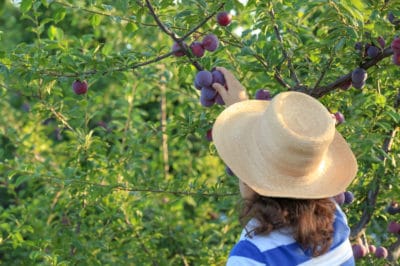Plum Varieties and Harvest Dates
Common plum varieties grown in the U.S. come in three major groups:
- American plums (Prunus Americana), height 15 feet (4.6 meters), has thorns, grows well as an ornamental zones 3 to 8. Harvest mid-July through September.
- Japanese plums (Prunus salicina), height up to 20 feet (6 meters), zones 5 to 9. Harvest mid-July through mid-September.
- European plum (Prunus domestica) height up to 25 feet (7.6 meters), many sub-varieties adapted to all climate zones. Best type for drying. Harvest between May and September.
Harvesting Ripe Plums
Japanese varieties of plum ripen after picking, but don’t pick them too early. Watch for the color of the fruit to change as ripeness approaches. Feel for a slight give in the flesh, and then pick the plum by twisting it lightly as you pull it from the tree.
European varieties of plum for fresh eating or jam are best when picked dead ripe from the tree. Earlier producing varieties usually ripen over the course of several weeks, and later producing varieties often become ripe all at once. Watch for color change, softness, and ultimately, flavor by taste testing.
If you want to make prunes, European varieties are best. Let the fruit dry-out on the tree and then harvest it when it falls to the ground. Sterilize the fruit in a hot oven or food dehydrator before storage.
Problems with Plums Ripening
Plum trees produce better if they are planted in a good location, watered regularly in summer, fertilized annually, and pruned each year.
Many types of plum need another plum tree of the same group but a different variety in order for flowers to be fertilized and fruit to set. If you have a single plum tree, you may not get a good harvest of fruit, no matter how well you care for the tree.
Plum trees must grow for four to six years before they start producing a significant crop of fruit, and they reach maximum production in eight to 12 years. If your tree is too young, it won’t have much fruit.
Damage to blossoms in spring can wipe-out fruit production for the season. Plant plum trees where they are protected from late frosts.
Storing Plums after Picking
If plums are slightly under ripe, put them in a paper bag away from direct sunlight at room temperature to ripen more.
Once plums are fully ripe, store them in a plastic bag in the refrigerator where they will keep for about five days.
